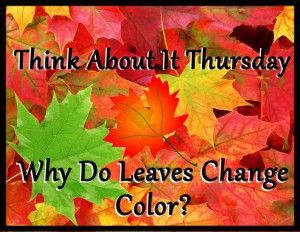Leaf color comes from pigments. Pigments are natural substances produced by leaf cells. The three pigments that color leaves are:
- chlorophyll (which produces the green color)
- carotenoid(produces yellow, orange, and brown colors)
- anthocyanin (produces a red color)
Chlorophyll is the most important of the three. Leaves contain chlorophyll in order to use the sunlight to produce its own food through the process of photosynthesis.
Carotenoids are organic pigments that are found in the chloroplasts and chromoplasts of plants and some other photosynthetic organisms. Carotenoids create bright yellows and oranges in familiar fruits and vegetables. For example, corn, carrots, and bananas to name a few.
Anthocyanins are pigments that may appear red, purple, or blue depending on the pH, they add the color red to plants, including cranberries, red apples, cherries, strawberries and others.
In the fall, because of changes in the length of daylight and changes in temperature, the leaves stop their food-making process. The chlorophyll breaks down, the green color disappears, and the yellow to orange colors become visible. Most anthocyanins are produced only in autumn, and only under certain conditions. Not all trees can make anthocyanin, but sugar maples seem to have the easiest time in doing so.
Resources: State of New York: College of Environmental Science and Forestry: http://www.esf.edu/
Dnr.wi.gov- Environmental Education for Kids: http://dnr.wi.gov/org/caer/ce/eek/veg/trees/treestruecolor.htm

